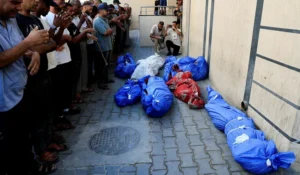Gaza death toll Passes 60,000: ‘No one asks how many died, only who survived today’

Mourners pray during the funeral of Palestinians killed in an early morning Israeli airstrike on a house, according to medics, at Al-Awda Hospital in Nuseirat, central Gaza, 29 July 2025
Jack Khoury reports in Haaretz on 29 July 2025:
The number of people killed in the Gaza Strip since the start of the war on October 7, 2023, has surpassed 60,000, the Hamas-run Health Ministry said on Tuesday.
While most of the casualties over the 21-month war were caused by Israeli airstrikes, Gazan officials are now highlighting deaths due to malnutrition and incidents near aid distribution centers.
Palestinians say the ubiquity of death has rendered the tally meaningless. “Here in Gaza, no one asks how many died anymore. They ask who survived today, who managed to find a loaf of bread, who had milk for their baby,” said a mother of three. “I don’t think anyone is moved by numbers anymore.”
A physician at Gaza City’s Al-Shifa Hospital told Haaretz that for most people, survival has become the sole focus. “There’s no time to grieve in the hospitals,” he said. “Doctors are working with improvised tools, mothers search empty markets for baby formula, and fathers risk their lives standing in endless lines for aid that might never come.”
According to a report issued by Hamas’ Media Office on July 18, which cites data from the Health Ministry, around 60 percent of those killed since the war began are minors, women, or the elderly. That includes some 19,000 children – 953 of them under the age of one – and approximately 12,500 women, including 8,150 mothers. Only about 9,500 of the women’s bodies have been formally identified.
The report also states that 2,163 families lost all of their loved ones – 7,563 people in total – while 5,943 families have only a single surviving member. Among the dead are 1,590 medical personnel, 122 civil defense workers, 228 journalists, 171 municipal employees and 777 security and aid protection staff.
The actual number of casualties could be significantly higher. Thousands of bodies are believed to still be buried under rubble and remain unrecorded. Around 7,000 people are listed as missing.
To draw international attention and increase pressure on Israel to end the war, local officials in Gaza have scaled back daily reports of airstrike casualties and now highlight only large-scale incidents.
“In the beginning, we reported every death from bombings, but now we only report exceptional strikes that kill dozens,” said Imad, a field journalist and social activist who spoke with Haaretz. “Over the past two weeks, the focus has been on those killed near aid centers, but now the Health Ministry wants to spotlight those dying of starvation and children who succumb to malnutrition.”
Dr. Munir al-Bursh, the director general of Gaza’s Health Ministry, criticized the so-called “humanitarian pauses” recently announced by the IDF. “They don’t feed the hungry or save the wounded,” he said. “While children writhe in hunger, mothers collapse at the gates of hospitals that no longer function.”
The number of starvation deaths rises daily. According to ministry data released Monday, 147 Palestinians – including 88 children – have died of malnutrition since the war began. As of July 18, more than 3,500 pregnant women had suffered miscarriages due to hunger and vitamin deficiencies.
Others are killed in the act of trying to find food. Those who die seeking aid are known locally as the “bread-seekers.” Many have been killed in Israeli strikes targeting distribution sites run by the Gaza Humanitarian Foundation (GHF). As of Monday, the Health Ministry reported that 1,157 people had been killed by Israeli fire near these centers.
Throughout the war, Gaza’s Health Ministry has repeatedly called for the evacuation of critically wounded patients and the entry of medical equipment, infant formula and nutritional supplements – appeals that have either gone unanswered or received inadequate responses. “Every delay ends in another funeral,” said Dr. al-Bursh. “Every silence means another child dying in their mother’s arms without medicine or food.”
Alongside the casualties of war and starvation, many chronically ill Gazans are struggling to survive. According to the media office, 41 percent of kidney patients in Gaza have died since the war began. In a report published earlier this month, it noted that 17 people – including 14 children – died of hypothermia in displacement camps in the Strip.
This article is reproduced in its entirety
